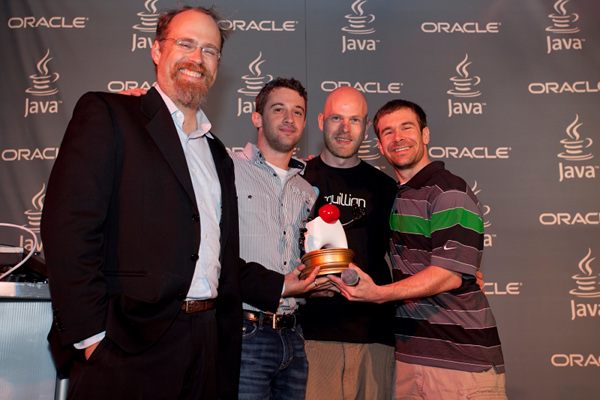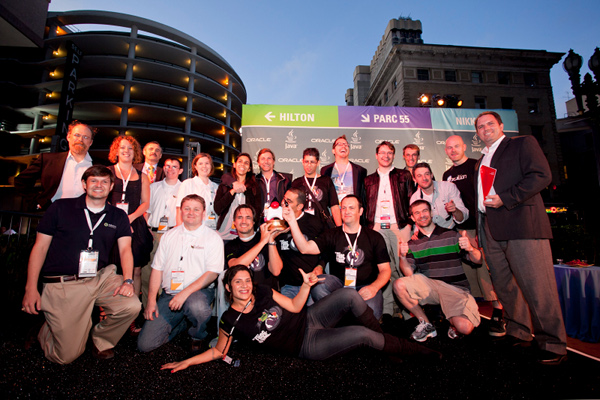Bug killing proposals accepted for 2012 Google Summer of Code!
 The much anticipated announcement about which students were selected to participate in the 2012 Google Summer of Code program was published earlier today. In total, there are 1,212 students participating. We’d like to congratulate all the students accepted and wish you all best of luck this summer!
The much anticipated announcement about which students were selected to participate in the 2012 Google Summer of Code program was published earlier today. In total, there are 1,212 students participating. We’d like to congratulate all the students accepted and wish you all best of luck this summer!
The JBoss Community is proud to be participating as an independent mentor organization for the first time this year. We were selected thanks to a strong showing of volunteer mentors and an overwhelming number of compelling and creative ideas. More than half of the ideas came from the Arquillian community ~:)
I’d like to extend a big thank you to everyone who came forward with ideas. Acceptances aside, these ideas are already helping shape the future of the various JBoss projects.
Accepted projects
The Arquillian project is excited to announce that we have 2 students participating this year!
 Google granted the JBoss Community 8 student slots. From those 8 slots, Arquillian was allotted 2 slots—far less than the number of excellent proposals submitted. After much agonizing over the decision for the last week, the Arquillian mentors decided to award the slots to the following two student proposals:
Google granted the JBoss Community 8 student slots. From those 8 slots, Arquillian was allotted 2 slots—far less than the number of excellent proposals submitted. After much agonizing over the decision for the last week, the Arquillian mentors decided to award the slots to the following two student proposals:
Project #1
| Title | Extend Arquillian to support Spring testing (beans and MVC controllers) |
|---|---|
| Student | Jakub Narloch |
| Mentor | Marius Bogoevici |
| Summary | Arquillian provides an extensible testing platform that can be used for testing any type of Java-based component. The initial focus for Arquillian was testing Java EE components, such as CDI beans, EJBs and JPA. However, Arquillian provides all the infrastructure and hooks necessary to make it an ideal testing platform for Spring applications. So the main of this project would be introducing suport for Spring testing. |
Project #2
| Title | Automated Visual Verification |
|---|---|
| Student | Jakub Dunia |
| Mentor | Lukas Fryc |
| Summary | Testing is important part of development. It is a procedure we need to perform many times, that is why there are many tools to automate it. There are cases where it is not that easy, like Visual Verification. Normally we need real person to check whether the web page looks good or not. The goal of this project is to write a tool that allows to easily review set of automatically collected screenshots generated by tests, and also improve existing comparision algorithms. |
Jakub Narloch is already well on his way to bringing Spring testing support to Arquillian having implemented a prototype. You can read about the status of his prototype in the GSoC – Arquillian Spring integration forum thread.
Jakub Dunia, with his insight into problem solving, has already demonstrated he’ll be invaluable member of our community. The project he has chosen to support is extremely innovative, not only in scope of Arquillian, but in UI testing in general.
Congratulations Jakub * 2!
There’s an additional testing-related proposal, sponsored by the Errai team, that was also accepted:
Project #3
| Title | A Jenkins plugin to visualize Jacoco code coverage reports |
|---|---|
| Student | Ognjen Bubalo |
| Mentor | Jonathan Fuerth |
| Summary | JaCoCo is a tool which generates code coverage reports based on Java unit tests. The project is about writing a Jenkins plugin to visualize JaCoCo code coverage reports. |
Congratulations Ognjen!
Next steps
Jakub, Jakub and Ognjen, please contact your mentors immediately. Make a plan to communicate with your mentor regularly, at minimum, once each week. Since we’re big believers in openness, the best way to keep in touch is through a public channel such as the Arquillian development forum or the #arquillian channel on Freenode IRC.
We plan to publish status reports on these projects here at arquillian.org to allow the community to follow your progress and provide feedback. For those watching, stay tuned!
Promising proposals
Although we could only accept two proposals, there were many well-written proposals that truly deserved a slot (if only we had more to give). I’d like to thank the students for the time they spent preparing and submitting the proposals by highlighting them here. The rating shown under each proposal is the average rating (out of 5) given by the JBoss mentors who voted.
- Unleash the Jester on integration tests by adding support for mutation testing in Arquillian
Student: Adam Sznajder
Rating: 5 / 5- Server-Side Performance Testing Framework reusing Arquillian Core
Student: Oliver Kišš
Rating: 4.8 / 5- RushEye Manager for Automated Visual Verification
Student: Udesh Liyanaarachchi
Rating: 4.5 / 5- Integrate Robotium into Arquillian Drone and Android extensions for complete automated application testing on Android
Student: Aleksey Shilin
Rating: 4.25 / 5- Provide an object-oriented format for defining test data for the Arquillian Persistence Extension
Student: Martin Skurla
Rating: 4 / 5- Automate JavaScript tests in an integration environment using Arquillian
Student: Chaitanya Nalla
Rating: 3.67 / 5- Provide an object-oriented format for defining test data for the Arquillian Persistence Extension
Student: Houssem
Rating: 3.67 / 5- Integrate Sahi into Arquillian Drone for automated browser testing
Student: Asanka Amarasinghe
Rating: 3.5 / 5
Despite the fact that these proposals were not accepted into GSoC, we really want to see them pursued. We view this program as an opportunity to interact with the next generation of the JBoss Community and to help them discover, or reinforce, their passion for open source. In fact, several students, including Chaitanya Nalla, have already expressed interest in contributing to Arquillian despite not being accepted to GSoC. That’s the spirit!
As Anil mentioned on the JBoss GSoC mailinglist, we’re exploring a diverse approach to enable students to continue their proposals, ranging from Red Hat summer internships to community-supported projects. Our plan is to closely track the GSoC schedule to keep the projects on track and to give you, the students, the experience the comes with completing a summer project (and likely increase your chance of being awarded a slot next year). Stay tuned for details.
What’s next?
Keep an eye on this blog for periodic progress reports about the GSoC student projects and any additional non-GSoC summer projects.
The first milestone is May 21st, when coding officially begins (trust me, these guys will be way ahead of that scheduled date). The mid-term evaluations happen mid July and the projects wrap up in mid August. See the official timeline for all the dates.
Even when GSoC ends, the community continues on! We hope summer students stay involved in the community long after the hacking days of summer.
 Red Hat, Inc. and the JBoss Community today announced the 1.0.0.Final release of
Red Hat, Inc. and the JBoss Community today announced the 1.0.0.Final release of 

